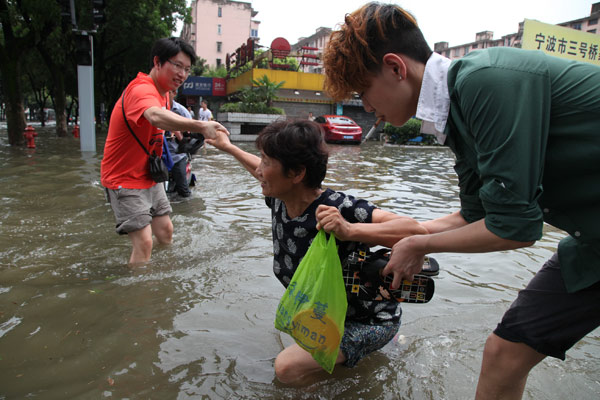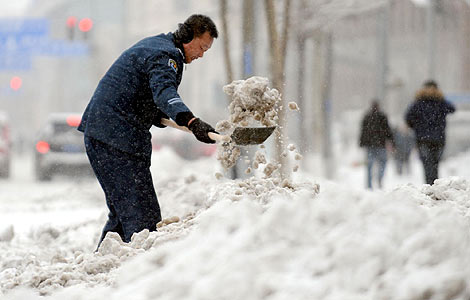
Torrential rain from Haikui continues to threaten a large part of East China as the typhoon hovers over the area.
The third typhoon to hit China in a week, Haikui snuck into inland Anhui province on Wednesday night after shattering the coastal area with strong winds and torrential rain, killing at least four and forcing 2.14 million residents in East China to evacuate.
 |
|
Residents form a chain as they negotiate fl oodwaters in Ningbo, Zhejiang province, on Th ursday, aft er Typhoon Haikui lashed East China. Provide to China Daily |
As of 8 pm on Thursday, Haikui affected more than 6 million people in Shanghai, Zhejiang, Jiangsu and Anhui provinces, Xinhua News Agency quoted the latest figure released by the Office of State Flood Control and Drought Relief Headquarters on Thursday night.
It lessened to a storm and then a tropical depression - the lowest level of a tropical cyclone - at noon Thursday near Anhui's Chizhou. Its center was near Anqing at 5 pm on Thursday, packing up winds up to 16 meters per second.
China's National Meteorological Center said Haikui's strength would ebb slowly as it lingered in the southern part of Anhui.
"More than 24 hours after it landed, Haikui still remained a storm and that shows it is very powerful," the center said.
It also forecast that rainstorms would continue to batter parts of Jiangsu, Anhui, Zhejiang, Jiangxi, Fujian and Shandong provinces on Friday with rainfall reaching 200 millimeters.
In Anhui, 1.35 million residents have been affected by the storm and 156,000 residents evacuated as of Thursday as winds and rainstorms destroyed crops, damaged roads and threatened the area with floods and mudslides.
Haikui also destroyed 53,000 hectares of crops, damaged 13,700 houses and caused direct economic losses of 670 million yuan ($105 million) in the province.
The biggest threats are from floods and mudslides, Cai Zhengzhong, spokesman for the Office of Anhui Flood Control and Drought Relief Headquarters, said on Thursday.
The provincial government has banned outdoor group activities unrelated to flood control and demanded strengthened management on people traveling outdoors.
Schools, training institutions, scenic spots and entertainment venues that might pose safety hazards were requested to close.
The government also ordered the reinforcement of flood control projects and enhanced patrols at rivers and reservoirs.
Authorities in the city of Huangshan evacuated 19,000 people before the typhoon arrived on Wednesday night.
In Shanghai and Zhejiang, where the influence of Haikui has greatly subsided, urban centers slowly came back to life, though the typhoon has pushed up the price of some commodities.
The two airports in the financial center of Shanghai resumed operations Wednesday night, and prolonged operations to transport nearly 2,000 stranded passengers.
On the ground, more than 100 high-speed trains linking Shanghai with other cities remained suspended on Thursday, though the city lifted its red alarm for Haikui on early Thursday.
Haikui, which means "sea anemone", came on the heels of Saola and Damrey, which caused extensive damage to coastal China earlier this month.
Meteorologists said that the typhoons that landed on the Chinese mainland this year outnumbered and were more powerful than those in previous years.
People's Daily cited Gao Shuanzhu, a senior engineer at China Meteorological Administration, as saying on Thursday that it is rare for three typhoons to land in 10 days but that could be explained by the fact that July and August are the peak seasons for typhoons to form in the northwestern Pacific.
Ye Dianxiu, chief weather forecaster at the administration, told the newspaper 12 tropical cyclones have formed since the beginning of this year. Of the 12 storms, five landed on the mainland.
In addition, Damrey landed within 12 hours of Saola, the shortest time bracket recorded. The previous record is 24 hours.
In July, 61.8 million residents were affected by natural disasters in China, with 402 people killed, 91 missing and 4.6 million people relocated or needing emergency relief, the Ministry of Civil Affairs said.
Contact the writer at wangzhenghua@chinadaily.com.cn







